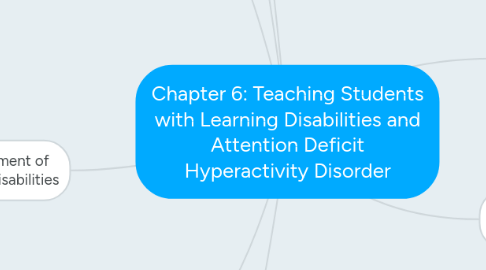
1. Characteristics of Students with Learning Disabilities
1.1. Unexpected Difficulty (their learning disability could be unexpected)
1.2. Ineffective or inefficient Information processing
1.3. Reasons for the student's low performance can be due to their strengths and weaknesses and the learning strategies they employ
1.4. Low achievement in one or more academic area
1.5. does not understand or follow directions correctly
1.6. difficulty with handwriting and visual and auditory sequential memory
1.7. difficulty memorizing words and allocating time and organizing work
1.8. difficulty segmenting words
1.9. difficulty with letters, confuses b and d and was and saw
1.10. poor reading skills
1.11. cannot do rapid naming of pictures, words, and numbers tasks
1.12. cannot use learning strategies effectively
1.13. Dyslexia, Dysgraphia, Dyscalculia
2. Identification and Assessment of Students with Learning Disabilities
2.1. Students with LD are identified because of difficulties with academic achievements
2.2. Teacher must take the following into consideration before referring students with LD:
2.2.1. in which area are the students having difficulty
2.2.2. what are the academic achievement in these areas
2.2.3. how does the student compare to other students in areas of success
2.2.3.1. Prevalence of Learning Disabilities
2.2.3.1.1. A lot more students are being identified as having a learning disability nowadays than in the past.
2.2.3.1.2. 4% has been identified as the right percentage for students with learning disabilities
2.2.4. what could be contributing to the learning disorder being shown
2.2.5. is language a factor?
3. Instructional Techniques and Accommodations for Students with Learning Disabilities
3.1. Students with LD are very diverse
3.2. Common practices predictors of the academic success of students
3.2.1. Controlling task difficulty
3.2.2. teaching students with LD in small groups
3.2.3. Using graphic organizers
3.2.4. Using combinations of direct instruction and cognitive strategy
3.2.5. providing modeling and think out louds
3.2.6. teaching students to self-regulate
3.2.7. providing opportunities fr extended practice with feedback
4. Attention Deficit Hyperactivity Disorder
4.1. Students with LD demonstrate attention problems
4.1.1. ADHD: Attention deficit hyperactivity disorder
4.1.2. ADD: attention deficit disorder
5. Definitions and Types of Attention Deficit Hyperactivity Disorder
5.1. ADHD, Inattentive type
5.2. ADHD, hyperactive-impulsive type
5.3. ADHD, Combined type
5.3.1. Hyperactivity: fidgeting, squirming, running excessivley
5.3.2. Impulsive: blurting out answers, difficulty waiting for their turn, interrupting others
6. Characteristics with students with LD are heterogeneous, and the types of learning accommodations vary.
6.1. teaching students at their instructional levels
6.2. provide a framework for instructions
6.3. use learning tools and aids
7. Learning Disabilities; Definition and Types of Learning Disabilities
7.1. According to the rules of the IDEIA a students has a learning disability if: student's level does not match with his classmates in terms of learning experiences, the student did not respond well to a scientific research based intervention, the student needs special education (the exception being if the student has a deficit relating to their vision, hearing, emotional disturbance, etc.)
8. Diagnosing students with learning disabilities
8.1. Distinguishing between a learning disability and learning problem can be very difficult
8.1.1. It is better to use multiple data sources than IQ testing. Identifying learning disabilities in small children can be very difficult, therefore it has been established that if student has issues with reading in third grade, chances are they will for the rest of their lives
